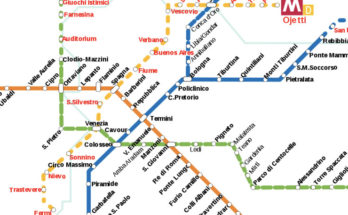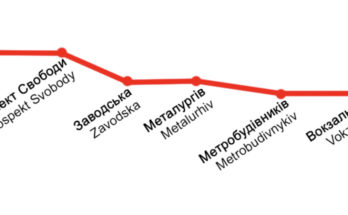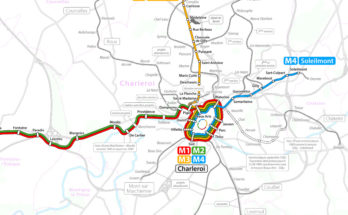In the city of Munich, the transit system comprises the Munich U-Bahn, an underground electric rail rapid transit network, and the Munich S-Bahn a commuter train system that forms a dense urban transport network that make it easier the movement of the Bavarian capital.
U-Bahn is the contraction for Untergrundbahn (underground train) in german and S-Bahn for Stadtschnellbahn (urban rapid rail).
The U-Bahn has 6 lines and over 98 stations. Complementing U-Bahn network there are suburban train lines (S-Bahn), trams and buses. U-Bahn has more than 330 million passengers per year. Today, the S-Bahn covers most of the populated area of Munich, a population of about 2.7 million people.
The two systems are very integrated and use a common ticketing scheme. To find out if a train belongs to UBahn or SBahn you just have to check out its color: U-Bahn trains are blue and white and S-Bahn trains are red and white.
Contents
Munich U-Bahn. General info
- Known as: U-Bahn
- System length: 64 miles
- Nº of lines: 6
- Nº of stations: 100
- Top Speed: usually speed below 50 m/h
- Official Site: www.mvg-mobil.de, www.mvv-muenchen.de
- Operator: It is operated by the municipally owned Münchner Verkehrsgesellschaft (the Munich Transport Company) or MVG. The network is integrated into the Münchner Verkehrs- und Tarifverbund (the Munich Transport and Tariff Association).
- Average Ridership: 330 per year, over 962,000 per day.
- Air conditioning: no.
- Start of operation: It opened on October 19, 1971 with a 7 miles route between Kieferngarten station and Goetheplatz station.
Munich U-Bahn Lines and stations
- U1 – from Olympia-Einkaufszentrum station to Mangfallplatz station (15 stations in between)
- U2 -from Feldmoching station to Messestadt Ost station (27 stations)
- U3 -from Olympia-Einkaufszentrum station to Fürstenried West station (25 stations)
- U4 – from Westendstraße station to Arabellapark station (13 stations)
- U5 – from Laimer Platz station to Neuperlach Süd station (13 stations)
- U6 – from Garching-Forschungszentrum station to Klinikum Großhadern station (26 stations)
Hauptbahnhof is the most important station of long distance of U-Bahn and S-Bahn. The lines U1, U2, U4 y U5 pass through it. Another important connecting station is the Odeonsplatz station (lines U3, U4, U5, U6).
Munich S-Bahn Lines and Stations
- S1 LINE – Freising / Munich Airport – Flughafen München Besucherpark / Neufahrn – Oberschleißheim – M.-Feldmoching – M.-Moosach – M.-Laim – M.-Donnersbergerbrücke – M-Hbf. – M.-Karlsplatz (Stachus) – M.-Marienplatz – M.-Ostbf.
- S2 LINE– Petershausen – Dachau(*) – M.-Allach – M.-Laim – M.-Donnersbergerbrücke – M-Hbf. – M.-Karlsplatz (Stachus) – M.-Marienplatz – M.-Ostbf.(*) – M.-Leuchtenbergring – M.-Berg am Laim – Markt Schwaben – Erding
- S3 LINE – Mammendorf – Maisach(*) – Gröbenzell – M.-Pasing – M.-Laim – M.-Donnersbergerbrücke – M-Hbf. – M.-Karlsplatz (Stachus) – M.-Marienplatz – M.-Ostbf. – M.-Giesing – Deisenhofen(*) – Holzkirchen
- S4 LINE – Geltendorf – Grafrath – Buchenau – Fürstenfeldbruck – M.-Pasing – M.-Laim – M.-Donnersbergerbrücke – M-Hbf. – M.-Karlsplatz (Stachus) – M.-Marienplatz – M.-Ostbf. – M.-Leuchtenbergring – M.-Berg am Laim – M.-Trudering – Zorneding(*) – Grafing(+) – Ebersberg
- S6 LINE– Tutzing – Starnberg – M.-Westkreuz – M.-Pasing – M.-Laim – M.-Donnersbergerbrücke – M-Hbf. – M.-Karlsplatz (Stachus) – M.-Marienplatz – M.-Ostbf. – M.-Leuchtenbergring – M.-Berg am Laim – M.-Trudering – Zorneding)
- S7 LINE– Wolfratshausen – Höllriegelskreuth – M.-Solln – M.-Siemenswerke – M.-Harras – M.-Heimeranplatz – M.-Donnersbergerbrücke – M-Hbf. – M.-Karlsplatz (Stachus) – M.-Marienplatz – M.-Ostbf. – M.-Giesing – Höhenkirchen-Siegertsbrunn – Aying – Kreuzstraße
- S8 LINE– Herrsching – Weßling(+) – Germering-Unterpfaffenhofen(*) – M.-Westkreuz – M.-Pasing – M.-Laim – M.-Donnersbergerbrücke – M-Hbf. – M.-Karlsplatz (Stachus) – M.-Marienplatz – M.-Ostbf. – M.-Leuchtenbergring – Ismaning – Flughafen München Besucherpark – Munich Airport
- S20 LINE– M.-Pasing – M.-Heimeranplatz – M.-Siemenswerke – M.-Solln – Deisenhofen
- S27 LINE– Hauptbahnhof – M.-Donnersbergerbrücke – M.-Heimeranplatz – M.-Harras – M.-Siemenswerke – M.-Solln – Deisenhofen
S-BAHN A LINE – Altomünster – Dachau
Munich U-BAHN schedule and frequency:
Start to run at 4:15am and finish to 1:30am, it pass every 5 minutes in rush hours and avery 10 minutes in the rest of the day. After 00:00am it passes every 20 minutes, and the weekend is every half hour.
Munich S-BAHN schedule and frequency:
Is every 20 minutes. On parts of some branches during peak hours there is a 10 minute frequency produced by added trains. A special case is the line to Erding, where on weekdays a mix of express trains from Erding and normal S-Bahn trains from Markt Schwaben runs in the morning peaks, producing a 10 minute frequency west of Munich East station.
How to use U-BAHN and S-BAHN in Munich
Tickets can be purchased from a vending machine in any U-Bahn or S-Bahn station.
There are 4 types of tickets:
- Einzelfahrkarten (single-journey point-to-point tickets) are the most expensive. With Einzelfahrkarten You can use 4 different types of transportation ( S-Bahn, U-Bahn, and tram or bus) if you wish.
- Single-Tageskarten and Partner-Tageskarten, or single and partner day tickets, allow unlimited transportation from the time you buy it until 6 am the next day. There are individual tickets and tickets for groups of up to 5 people.
- CityTour Card one-day or three-day versions, for either the proper city or the entire Munich area. In addition to unlimited public transportation, it entitles you to discounts at many museums and other attractions.
You can pay for tickets with credit card at the MVG ticket machines located in U-Bahn (underground) stations or in MVG customer service centres or at the ticket machines located at Munich Airport.
You can validate your ticket or City Tour Card in the blue time-stamping machines near the station entrance or you can be fined otherwise. There are no turnstile. Just you will need to show your ticket to inspectors in the trains.
One thing to be aware is that in a few central locations, such as the Hauptbahnhof, there are two platforms: right-hand doors are for leaving, and left hand doors are for people boarding.
Munich Metro Rates:
- Day Ticket: 2.60 €
- Single Ticket: 1.30 €, 1,25 € for children aged 6-14.
- Single Day Ticket: 5.80 € (one day), 14.30 € (3 days) and is for a person from the age of 15 and up. It can be used within the selected area of validity for as many trips as you like on one day.
- Partner Day Ticket: 10.60 € (one day), 24.60 € (3 days) and can be used by the group within the selected area of validity for as many trips as you like on one day.
- The Children’s Day Ticket: 2.80 € (one day) and is valid for one child between the ages of 6 and 14 years. You can make as many trips as you like within the entire network.
- The CityTourCard is available as a Single or Partner Ticket for a group of up to 5 adults, whereby any two children between 6 and 14 years of age count as one adult.
- Single Ticket: 9.90 € (1 day Inner District), 20.90 € (3 days Inner District) and 32.90 €( 3 days Entire Network)
- Partnet: 17.90 € (1 day Inner District), 30.90 € (3 days Inner District), 53.90 € ( 3 days Entire Network).
.
.
From Munich to the Airport
Munich Airport can be reached on the S8 line via Ostbahnhof and Ismaning, S1 branch with transfer to U2 at Feldmoching.
The S-Bahn trains run between the city’s two central railroad stations (the Hauptbahnhof and the Ostbahnhof) and provide frequent transportation between the city and Munich International Airport. The Airport-City Day Ticket is available as a single ticket or as a partner ticket for up to 5 people.
Curious Facts about Munich Ubahn
Munich Bahn system is the third metropolitan transport system by extension in Germany, after Berlin and Hamburg systems.
The main reason of its construction was to provide the city with modern infrastructures for the 1972 Olympic Games.



